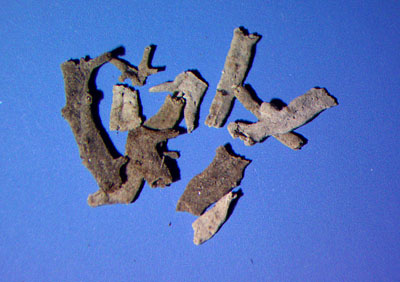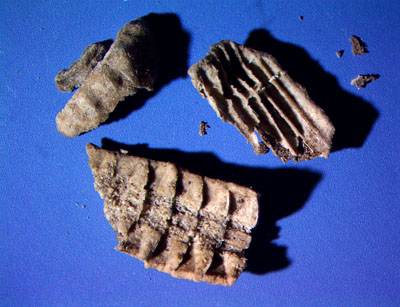|
Our Survey
this week included all of site 4, which zone 1 had limestone
and zone 2 (the second half) was only red Shnebly Hill Sandstone
and was without fossils. Fossils in Site 4 were few and far between,
most rock had no visible silicified fossils at all. Preservation
was moderate to poor, and the fossil types found were few in
number.
Lets review so
far all the sites covered, with this map. As I mentioned before,
I am posting this map to encourage other microfossil collectors
to visit this area. It is strictly for microfossils - Very few
normal size fossils can be found.
 |
Here we see
all four sites plus Three more that are in the process of exploration.
The parking area for the trail is at lower left. Two outcrops
occur. The Outcrop 1 is the main outcrop surveyed so far, and
we are looking at the scree slope material as it flows over the
trail. It is not possible to actually go to the outcrops, since
they are on extremely steep cliffs. Outcrop 2 does indeed have
more fossils and will be the study area soon.
Click to enlarge
to full size
|
What was found
As far as what
was found in a one gallon zip lock bag of rock, this list highlights
the best preserved specimens:
1. A very small amount of Urchin material that was very poorly preserved
2. Half a dozen of poorly persevered Branching / Encrusting Bryozoans
3. THREE Serpulid Worm domiciles (Chonetes)
4. A Dozen nice Scaphopods - all small
5. Two species of Ostracods
6. Several dozen of both average - and poorly preserved Gastropods
7. Several water clear quartz crystals
8. Half a dozen tiny Trilobite bits
9. Dozens of small Bivalves - very generic
10. A few Straparollus gastropod parts
11. Four partial Brachiopods (other than productids)
12. One productid spine
13, One probable Orthocone Nautiloid
And here is what was NOT found that had been at other sites along the trail:
1. No Sponges or sponge roots
2. No solitary rugose corals
3. Not a single crinoid ossicle
4. No Bellerophontid Gastropods
5. No Metal coated sand grains
6. No larger fossils like productids or urchin spines
For a site so poor
in fossils, there were a few interesting surprises!
The
Fossil Photos.
A few words on
how these photos were taken. Using an Amscope stereo microscope,
one or two dozen shots of each subject were taken with the focus
shifted a bit between shots. The focus stacking software Picolay
was used to combine the images to obtain one frame of fully sharp
focus. Thousands of frames are treated in this manner and the
final images of the Fort Apache micro fossils you see here are
the results of a huge amount of work! Enjoy.
Trilobites:
 |
Phillipsia
sp. 15x For
such a poor site, we did find more trilobite Doublure (rims)
than the previous site. Thier color and composition is only shared
by the flat clam shaped ostracods - which are of course also
arthropods. |
Brachipods:
 |
Pseudodielasma
sp. 3.5x Four
brachs were found, three seen here and one to be illustrated
in the Chonetes section. Most surviving pieces are the umbo region
near the hinge, which appears strongest. |
Bryozoans:
 |
3.5x
The branching bryozonas made thier appearance, most being extremely
flattened. Why? |
Chonetids
(Serpulid Worms):
 |
10x
Three were found, a very small number indeed. Two are on the
surfaces of the shell of other invertebrates, and one loose.
On the left is the only loose one we found, which was more than
likely attached to a sea weed. The center specimen is on the
inside of a brach valve, and the third is on a mollusk. |
Bivalves:
 |
3.5x
This site had a few nice mollusks, including these bivalves.
No winged clams seen here however. |
Quartz
Crystals:
 |
15x
A few nice sand grain sized quartz crystals. Here we see some
individuals, a cluster and a flake of mica. |
 |
30x
Closer view of the quartz crystals. |
 |
40x
The single mica flake has significance. Mica normall forms in
either igneous granites or metamorphic rock such as gneiss or
schist. Many of the pieces we find are crystal shaped, and most
likely from granite washed in from the distant shore. |
 |
40x
Dark field microscope shot of one of the quartz crystals. |
 |
40x
Another dark field shot at 40x. |
 |
100x
shot showing a close up with the dark field microscope. |
Gastropods:
 |
3.5x
As found at most of the sites, gastropods are the dominant fossils.
Variety was poor here, and most were badly broken. |
Ostracods:
 |
Genus
and species indet. 15x Only
a small handful of ostracods were found, both the clam like and
ear shaped. |
Scaphapods:
 |
Plagioglypta
canna 3.5x Sizes
ranged from only a few mm to over an inch. Both smooth and ribbed
types found |
Productid
Spines:
 |
Bellaclathrus
spinosus 15x Only
ONE spine was found, very peculiar. This one looks like a mastadon
tusk... |
Nautiloids:
 |
3.5x
One orthocone nautiloid is seen here on the bottom. At upper
right seems to be part of the calice for a rugose coral, but
this is uncertain. The pieces on the upper left are most likely
urchin parts. |
Straparollus
Gastropods:
 |
Straparollus
kaibabensis 7x Only
a few fragments found. |
Urchin:
 |
Echinocrinus
trudifer 7x Very
few urchin pieces and get this - NO spines. |
|
